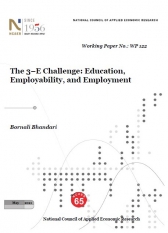The 3-E Challenge: Education, Employability, and Employment
Bornali Bhandari
May 2021
Demographic transition, economic uncertainty and technological changes have come together to create a concoction in India that has the potential to boil over economically and socially, if not skilfully managed. One path that could steady the future of India is to both create jobs that will absorb the burgeoning population and make the population work ready so that they can be absorbed in those same jobs. The three basic questions in economics contextualised within India’s skills market boils down to the following. What skills should we equip the workforce with? How should we equip them? For whom should we equip them? These questions are examined in the historical context to serve a dual purpose – first, to understand how they were answered in the past to derive lessons, if any, therefrom, and second, to understand why we are what we are today in terms of the education, employability and employment (3–E) challenge. The same questions are examined for the post-Independence era. While overall, skills as measured by education show a positive association with economic growth, drilling down shows several inconsistencies. Given the shortage of skilled workers and high demand for them, there is a high premium for skills, i.e., tertiary education. Prospective employees aspire for education that will enable them to get a secure job. However, a majority falter in the path and the ones who are able to get the education, still do not have the skills to get the aspirational job. With other channels of human capital investment limited, general educational attainment continues to present the only sustainable path. India is not addressing the micro distortions in terms of incentives and signals to employees (prospective or otherwise) and firms who make choices of about investments in education, on-the-job training, migration, creation of jobs, technologies to adopt, which in turn result in not addressing the above mentioned macro issues, thereby creating a vicious cycle.
Human Development and Data Innovation







